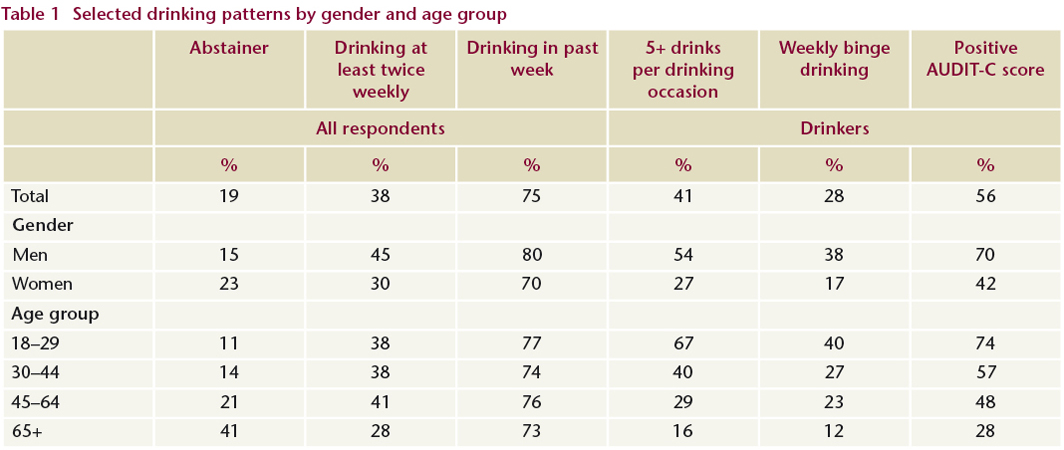Mongan, Deirdre
(2010)
Alcohol use in Ireland: results from SLÁN 2007.
Drugnet Ireland,
Issue 33, Spring 2010,
pp. 7-8.
On 1 December 2009, the SLÁN (Survey of Lifestyle, Attitudes and Nutrition) group published the results of the alcohol component of the 2007 SLÁN survey.1 This was the third SLÁN survey – previous surveys were conducted in 1998 and 2002. The survey involved 10,364 adults aged 18 years and over, representing a response rate of 62%. As part of the survey, participants were questioned in face-to-face interviews about their rates and patterns of alcohol consumption, harm from their own drinking and harm from others’ drinking.
Alcohol consumption and drinking patterns in Ireland
Four-fifths (81%) reported that they had consumed alcohol in the past year, with women (23%) more likely than men (15%) to be abstainers from alcohol. Higher rates of abstinence were reported by older respondents than by younger ones: for example, 41% of those aged 65 and over abstained from alcohol, compared to 11% of 18–29-year-olds. Three-quarters of the total number of respondents reported that they had consumed alcohol in the previous week, and 38% (45% of men; 30% of women) consumed alcohol at least twice a week.
Twenty-nine per cent of drinkers reported consuming 1–2 standard drinks on a typical drinking occasion. A standard drink was defined as a half pint or a glass of beer, lager or cider; a single measure of spirits; a single glass of wine; or a longneck bottle of alcopops. Two-fifths (41%) reported drinking at least five standard drinks on a typical drinking occasion. This was more common among men (54%) than women (27%) and among younger age groups.
One in 10 drinkers reported drinking over the recommended weekly alcohol limit (defined as 21 standard drinks for men and 14 standard drinks for women) and 28% engaged in weekly binge drinking (defined as consuming at least six standard drinks or 60g of alcohol on a single occasion). Drinking patterns were also assessed using the Alcohol Use Disorders Identification Test – Consumption (AUDIT-C), which identifies those with harmful drinking patterns by examining frequency of drinking, volume consumed and extent of binge drinking. Over half (56%) of drinkers had a positive AUDIT-C score. Applying this percentage to the 2006 population census figures,, one may extrapolate that 1,453,250 people in Ireland aged 18 or over have a positive AUDIT-C score. Male and younger drinkers were more likely to drink over the recommended weekly limit, to be weekly binge drinkers and to have a positive AUDIT-C score.

Harm related to respondents’ own drinking
One in 10 drinkers reported that their drinking had harmed their health in the previous year. Younger drinkers were more likely to report health harms; the percentages were: 17% of those aged 18–29; 10% of those aged 30–44; 7% of those aged 45–64; and 2% of those aged 65+. Drinkers who exceeded the recommended weekly limit were four times more likely to report that their drinking had harmed their health, while binge drinkers were three times more likely to report similar harm.
Harm to home life and/or marriage as a result of their own drinking was reported by 4% of men and 2% of women, while 6% of men and 3% of women reported that their drinking had harmed their work or studies in the previous year. Involvement in fights and/or accidents as a result of their own drinking was reported by 5% of drinkers (7% of men; 3% of women). Binge drinkers were almost five times more likely than non-binge drinkers to be involved in a fight or accident as a result of their own drinking.
Twelve per cent of drivers who were also drinkers reported driving a car in the previous year after consuming two or more standard drinks and this was reported more often by men (17%) than by women (5%). Self-reported rates of driving after consuming two or more standard drinks were similar across all age groups.
Harm related to other people’s drinking
Drinkers experienced more harm from others’ drinking than did non-drinkers. Six per cent of all respondents (5% of men; 7% of women) reported experiencing family or marriage problems in the previous year as a result of someone else’s drinking. Six per cent reported being pushed, hit or assaulted as a result of someone else’s drinking, with a higher rate (13%) reported by younger respondents. Binge drinkers were twice as likely to report being assaulted as all other respondents.
Conclusion
This report indicates that rates of alcohol consumption in Ireland are high and that our drinking patterns are problematic. Over one in four drinkers reported binge drinking weekly, and over half of drinkers scored positive on the AUDIT-C questionnaire, indicating that a large proportion of drinkers consume alcohol in a hazardous manner. This is worrying as the volume of consumption as well as patterns of drinking, especially regular heavy drinking, determine the burden of disease caused by alcohol. Binge drinking, apart from any long-term effects, can increase impulsivity, reduce inhibition and distort behaviour, which may lead to acute consequences such as accidents, assaults or suicide. There is a pressing need to introduce strategies that will reduce the harmful use of alcohol in Ireland and, by extension, the health and social harms it causes.
1.Morgan K, McGee H, Dicker P, Brugha R, Ward M, Shelley E et al. (2009) SLÁN 2007: Survey of lifestyle, attitudes and nutrition in Ireland. Alcohol use in Ireland: a profile of drinking patterns and alcohol-related harm from SLÁN 2007. Dublin: Department of Health and Children.
